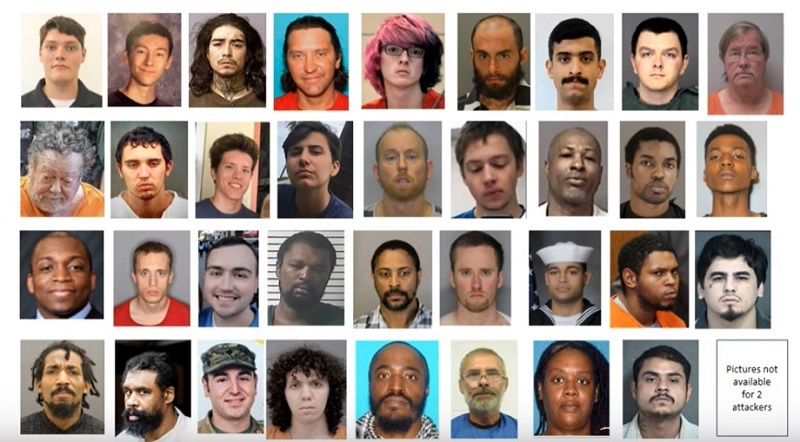

By Chief Joel F. Shults, Ed.D.
The search for the elusive predictive profile of active killers continues. The U.S. Secret Service recently published “Mass Attacks in Public Spaces” outlining statistics from attacks in the U.S. in 2018. As the world’s foremost experts on public violence, the United States Secret Service National Threat Assessment Center (NTAC) once again announces there is no profile of such attackers. While there is no template for these violent offenders, there are numbers and trends of interest.
“Between January and December 2018, 27 incidents of mass attacks – in which three or more persons were harmed – were carried out in public spaces within the United States. In total, 91 people were killed and 107 more were injured in locations where people should feel safe, including workplaces, schools, and other public areas” according to NTAC. Schools, of course, are of the most public and professional interest but comprise only three such attacks out of the 27, representing 29 of the 91 fatalities (31%) and 40 of the 107 injuries (37%). The most common places for a MAPS assault are commercial spaces, representing 20 of the 27 events.
For planning purposes, law enforcement tacticians and trainers working with the community to prepare for possible attacks can relate factors that are more than 50% likely in an attack.
1) The attack will last fewer than 5 minutes
2) The attacker will use firearms
3) The attack will happen between 7 in the morning and 3 in the afternoon on a Wednesday or Thursday
4) The attacker will end the assault on their own by leaving or killing themselves
5) The attacker has a grievance, mental illness, previous law enforcement attention, has expressed a threat or concerning communication, and suffered a recent stressor event
6) Friends, family, or neighbors have expressed concern for the attacker’s well being
7) Victims will be targeted randomly
8) The attacker will be male
9) The attack will be at a place of business
The most important fact to relate to potential targets is that the cumulative data from this 2018 report is not an exact match with the 2017 report. In other words, not only is every incident an anomaly that will defy the odds in various ways, but the data itself fails, once again, to be predictive.
The exceptions to the 50% chances above are many. The reader will notice the absence of the generic term “active shooter”. Vehicles were used in several MAPS assaults in 2018 and 2017, and edged weapons were used in many of the 2017 attacks. Over a third of the attacks will last more than 5 minutes. Police ended 22% of the attacks, firearms malfunction ended 15%, and bystander intervention ended 7% of MAPS events. Depending on the timely arrival and efficient action of law enforcement is not a sufficient strategy for dealing with these mass assaults.
Attacks can happen any time of day, any day of the week, and any month of the year. Interestingly, December was left alone by 2017 and 2018 attackers. The diversity of 2018 attackers defies the young white male stereotype.
Those who propose legislative remedies to mass attacks are frustrated by the randomness of attacker characteristics. Or, more accurately, the actual impact of legislated remedies is frustrated in the area of gun legislation and mental health. Of the 24 killers who used firearms, 10 possessed the weapons unlawfully, including 2 minors. Type of long gun, type of bullet, and weapon capacity surprisingly does not center on the infamous AR 15 or AK 47 alone. In a separate analysis of twelve 2018 firearms related mass killings (axios.com) only the Parkland attacker used exclusively an AR15. All other events cited on the axios.com chart showed the attacker in possession of more than one weapon, or a shotgun or handgun alone.
Distress and mental health issues were reported to have been present in examination of the 2018 killers based on testimony of those who knew them. Even so, only 44% had actual an actual diagnosis and prior treatment. In any given year, according to the National Institute of Mental Health, 20% of Americans show indicators of some level of mental illness.
Philosophers and mathematicians recognize limitations to predictability, commonly known as Chaos Theory. “Small differences in the initial conditions may generate very large differences in the final phenomena. A small error in the former will lead to an enormous error In the latter. Prediction then becomes impossible, and we have a random phenomenon.” A planner ignorning this reality is subject to preparing for the wrong thing.
The apparent randomness of mass violence events doesn’t mean that communities are powerless to intervene. The Secret Service advocates a comprehensive threat assessment team in communities and school in order to recognize and respond effectively to persons and situations that may portend violence. “While not every act of violence will be prevented, this report indicates that targeted violence may be preventable, if appropriate systems are in place to identify concerning behaviors, gather information to assess the risk of violence, and utilize community resources to mitigate the risk.”